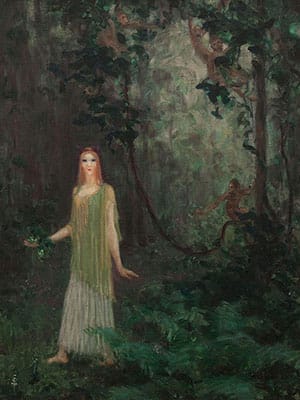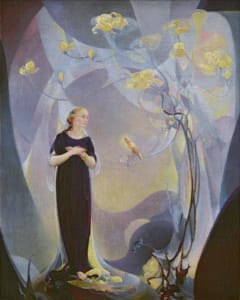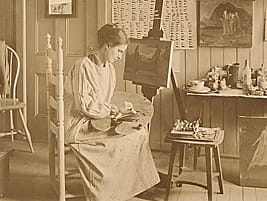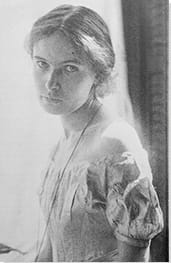Summary of Agnes Pelton
Visionary artist Agnes Pelton found her greatest muse in nature, a sanctuary where the painter enjoyed bouts of meditative silence and communion with the world. Interested in the higher consciousness beyond the mere appearances, she strove to express this relationship between observer and observed through work rich in ethereal Symbolism. Her visual vocabulary of fluid form, allegorical iconography, and luminescence were central elements in what would become known as Transcendental Painting.
Accomplishments
- Abstraction with spiritual infusion marks most of Pelton's work. As a painter, she was interested in producing an alternative to what was the modernist norm, that would present non-representational imagery sourced from her own creative imagination rather than objective observation.
- Pelton's non-traditional life of isolation, internal contemplation, and deep commitment to her painting practice was courageous and out of the ordinary for a woman of her time. Today she is viewed as an early feminist.
- Aside from her core visionary works, Pelton created many noted landscapes as a means of gaining steady income. Her later California desert paintings would become renowned for presenting beloved symbols of the natural environment, such as the smoke tree, in the artist's mystical fashion, hovering on the canvas, as if unveiling its own underlying soul. These works are important examples of Desert Transcendentalism, showcasing her role as a landscapist with mystical intent.
Important Art by Agnes Pelton

Vinewood
A female figure is pictured walking elegantly in a forest. Her large, dark eyes and long, auburn hair stand in stark contrast to her pale skin. She is dressed in long, flowing fabric that hides her figure and lends her an ethereal quality. One hand is held gracefully away from her body, the other carries flowers. Behind her, the dark forest seems to brood, its oppressive shadows and dense foliage almost threatening to overcome. Swinging from the trees are the energetic figures of apes, one of whose arms is outstretched, perhaps reaching for the enigmatic woman. Yet she appears completely comfortable within the unpredictability of the wild, and quite at peace with her solitude.
Vinewood is one of Pelton's early series of "Imaginative Paintings," and was included in the 1913 Armory Show. These paintings place her firmly within the Symbolist movement, and were greatly inspired by the art of Arthur B. Davies. Symbolist art sought to express inner ideas and emotions through imaginative use of subject matter and color, emphasizing subjectivity over objectivity.
These early works give insight into the artist's burgeoning journey as a private young woman prone to reliance on her inner life and its inherent universal connection to nature, a relationship that would later inform Pelton's interest in Transcendentalism. Her aim was to present the "moods of nature, symbolically expressed." Pelton closely associated the human figure with nature, and as Art Historian Michael Zakian has noted that "the pale young woman surrounded by wild apes represents the dichotomy between a life of contemplation and a life of animal impulse."
Oil on canvas
Tall Ginger
On a deep, textured background of smokey orange tones, a trio of pale red flowers stands amidst green stems and leaves that dominate the canvas. One flower, in full bloom, rises from the center of the composition. On the right hides a thin blossom, yet to unfurl. On the left, another burgeoning flower peeks out.
Painted during a trip to Hawaii in 1923-24, Tall Ginger is an excellent representation of Pelton's early nature paintings. Experiencing the tumultuous volcanic island made a huge impact on the artist's concept of the universe and its interwoven relationship with humanity. The deep red background of this piece expresses the hot sulking presence of volatility and unpredictability that leads the perpetual dance of this relationship.
This painting is understood to be her first symmetrical composition, which would become, along with the vertical format, central to her transcendental abstractions for years. Pelton's interest in nature was about more than simply physical form. For her, each entity in nature spoke of the greater whole, and of the timeless inevitabilities of birth, death, and renewal. Each study was informed by these eternal cycles and our unity with them. Where other Modernists studied nature purely in terms of its formal qualities, Pelton was concerned with its spiritual essence.
The Hawaiian works are darker in tone and color than her later more serene desert paintings, giving us insight into the way Pelton completely immersed herself into her surroundings, picking up on their unique properties both in visual hue and mood.
Oil on canvas
The Fountains
A misty gray-blue orb sits in the bottom-center of the canvas, surrounded by swirls of delicately rendered lines, curves, spirals, and circles, mimicking the free movement of water in a playful, bubbling fountain. The pale, pastel-heavy scene is placed upon an ethereal background of ambiguous origin, seemingly otherworldly.
This is one of Pelton's first abstract works, although we can see from its name, The Fountains, that it draws inspiration and form from the real world. Michael Zakian has noted that, for Pelton, "abstraction did not strip away references to reality," but rather it offered a means to "concentrate on reality's essential core." By abstracting essential aspects of the element of water, Pelton hoped to arrive at an essential truth that may not have been immediately apparent in everyday perception. Artist and critic Ann McCoy has noted that in many of Pelton's works, including this one, "the transparency of the shapes causes the viewer to enter the painting as though floating in a four-dimensional world, moving in and around the forms." In this way The Fountains invites the viewer into the paintings, and thereby includes the viewer in Pelton's mystical experience of water's beauty.
Overall, in true Transcendentalist fashion, a sense of tranquility is conveyed through the organic shapes and liquid movement, providing insight into Pelton's state of consciousness and her connection with the realms of spirituality that can be accessed when meditating with nature.
Oil on canvas
Incarnation
A red and pink flower floats in mid-air, suspended like a beatific deity on a glowing golden background, hovering above a stylized landscape below. Light blue shards suggest mountain peaks, small green domes evoke rolling hills, and tufts of milky white conjure clouds. The symmetrical composition presents the beauty of nature in all its unity and harmony. The upper sides of the work are framed in light brown folds as if drapes have opened into another dimension, giving a glimpse of a separate world, inviting the viewer into its fold.
Incarnation is unusual in Pelton's oeuvre in that it is a direct response to the work of Georgia O'Keeffe (to whom Pelton is often compared). Pelton was critical of O'Keeffe's series of flower abstractions, because she perceived them as too one-dimensional while Pelton strove to elevate nature in her own work as symbols of both beauty and spirituality. The flower here becomes likened to a life-giving sun or powerful deity, suspended in sky.
Incarnation also articulates Pelton's belief that her paintings were " little windows, opening to the view of a region, much visited consciously or by intention - an inner realm, rather than an outer landscape." In that respect, the piece is imbued with the Transcendental painters' desire to imbue spiritual intent into their abstractions of the natural world.
Oil on canvas
Ahmi in Egypt
In a fantastical landscape that seems to bridge material land and ethereal cosmos, a lone swan - bejeweled and crowned - bows its head at the base of a larger than life and golden lotus. In the lower darkness, a red, snaking path weaves a trail toward the flower standing aloft in a middle plane of glorious color, shape, and incandescence, connecting what is below to what is above, much like the merging of heaven and earth. A lone star hangs in the sky like a beacon, illuminating this path through time and space.
This abstraction differs from many others of the 20s and 30s, in that it is extremely asymmetrical. Michael Zakian notes the literary influence on this work, stating that "as in literature, it creates a fictional world unfolding through time," in which one may "take a spiritual journey through a fanciful landscape."
Three years before making this work, Pelton visited California for eight months to immerse herself in a spiritualist colony called the Glass Hive in South Pasadena. While there, she sketched many lotuses - a symbol of self-renunciation, protection, and enlightenment. Because both the swan and the lotus are allegorical figures, open to subjective interpretation, this piece reflects the Symbolist painting tradition.
Oil on canvas
Lone Smoke Tree of the Mojave
In a dry desert landscape, a lone smoke tree stands casting a long shadow in the late afternoon sun. A smattering of rocks and dusky shrubs sparsely occupy the landscape, but mostly the tree stands alone. The pale purples and blues of its flowers are echoed in the cloud-like mountains hugging the horizon line, and the blue sky which hangs above.
Although the main creative thrust, and perhaps the most rewarding practice lay in her abstract pieces, Pelton continued to paint landscapes throughout her life. The smoke tree, emblematic of the area surrounding her desert home, would appear in many works, of which would contribute to her income via the local tourist trade and the ability to perpetuate her more mystical art. However, these were not in any way soleless creations made purely for money. Not wanting her landscapes to become too literal, she searched for ways to avoid losing herself in an abundance of details. She decided, in her own words, to "try realism in 'free verse'." Using this approach, she only painted details where they were necessary, leaving large areas bare, underworked, or merely suggestive. This can be seen here in the large areas of empty space, where minimal paint and brushwork suggests the ground, and in the sky which is rendered in a simple wash of blue.
Although more literal than most of her work, the smoke tree creations still manage to convey Pelton's core Transcendentalist mission of finding inspiration from the meditative stillness produced through communing with nature.
Oil on canvas
Interval
A luminous orb floats in the center of the canvas, around which linger a variety of tones, shapes, and lines. Paint is applied in thin layers, lending each element a sense of transparency, all consumed within a gentle glowing light.
The glowing circle, light-filled orb, or egg are common motifs in Pelton's work. The circle is, in many cultures, a symbol of unity and timelessness, associated with spirituality and divine order. As Ann McCoy notes, in Interval, "it is as though [Pelton] has captured divinity in this orb or egg, and it creates an energetic center, projecting these energies outward toward the viewer." In 1941, Pelton asserted that was her life's purpose to "establish centers of radiation in my paintings."
In the late 40s, Pelton returned largely to abstraction after a long period of landscape painting which had left her longing for "the intervals of timeless work with weightless substances or forms, pure immaterial color." The artist suffered chronic health issues throughout her life, and was often torn between the physical strain of creating abstract canvases, and the spiritually weightless relief she felt while painting them. In 1950, the year she painted this canvas, she stated with conviction: "Abstractions are my work. This house is their home. Spend no more than one third of your time on desert paintings and when at work on them, consider them like a little trip out in the desert, but your home as a place of abstract art expression."
Oil on canvas
Biography of Agnes Pelton
Childhood
Agnes Pelton was born in 1881 in Stuttgart, Germany to American parents Florence and William Pelton. Her earliest years were spent traveling around Europe and visiting America with her mother. In 1888, Agnes and her mother settled in Brooklyn, New York, where they lived with Agnes' grandmother Elizabeth. William Pelton did not settle in America with his family, preferring instead to continue traveling throughout Europe, and only occasionally visiting his wife and daughter. William suffered from several psychological issues, and experienced intense mood swings, melancholy, and insomnia. In 1891, when Agnes was just nine years old, he died of a morphine overdose in his brother's home in Louisiana. His death had a huge impact on Agnes, and she withdrew into herself, becoming quiet and private. When a friend mentioned her father Agnes sternly told her, "My beautiful tragic father is not to be talked about."
This impulse to keep personal matters private is something which Pelton grew up with. Her grandmother Elizabeth Tilton had been involved in a national scandal in the 1870s, one which hung over the family for many years to come. Elizabeth Tilton and her husband Theodore had been extremely well known and respected figures in both the suffrage and antislavery movements. When Elizabeth confessed to having had an affair with Henry Ward Beecher - "one of the country's most respected clergymen," a stigma fell upon the family. Theodore Tilton sued Henry Beecher for $100,000 in damages through a trial that lasted six months, became regular national news, and which Theodore ultimately lost. Shame, scarred the Tilton and Pelton families for many years to come. Agnes recalls that she was "brought up never to speak of it" and that the scandal "overshadowed" her.
As a result of this shame, and the loss of her father, Agnes Pelton was, in her early life, a sad and brooding young woman. Her mother, having no financial support, opened a music school in their home, where she taught piano and occasionally tutored English. Elizabeth Tilton lived with them until she died when Agnes was sixteen years old. Pelton stated that: "from the time of puberty at age thirteen I was much inclined to melancholy and tears which was probably aggravated by being the only child in a household of deeply religious and perhaps unnecessarily serious people."
Education and Early Training

Pelton attended the Pratt Institute from 1895 to 1900, where she studied painting with Arthur Wesley Dow. After graduating, Pelton fell seriously ill for six weeks, coming quite close to death at one point. She reflected that this illness "seemed to stop the creative impulse in painting," and so for the first seven years of the 20th century she entered a period of relative stagnation. During this time, she taught students in her mother's music school, and she fell in love with one of her mother's female pupils. Pelton spent many hours at home, waiting hopefully for the young woman to show up. Unfortunately, it was an unrequited love, and caused Agnes a great deal of heartache.
In 1907 Pelton began to paint again, and in 1910 she undertook a trip to Italy, where she was greatly inspired by the unity and vision of Renaissance paintings. From 1911 to 1914 she studied with Hamilton Easter Field in Ogunquit, Maine. Her first original works were created during this time - a series of paintings Pelton called her "Imaginative Paintings." The work was heavily symbolic, and often featured lone women in natural settings. Two of these paintings were exhibited in the pivotal exhibition of modern art in America - the 1913 Armory Show.
Mature Period

In 1921 Pelton moved into an unused windmill near Southampton, Long Island. Here, she hoped to develop her own practice, while also making an income painting portraits of wealthy summer residents. She lived there in relative happiness for 10 years, undertaking contemplative studies of nature and developing her abstract style. For Pelton, each aspect of nature which she studied - whether plant, season, weather, or mountain - was indicative of the wider systems of the world, and the harmonious unity of all. This understanding of the world around her became central to her abstract visions, the first of which she created in 1926. During this time Pelton developed a body of abstract images which would recur throughout her career, including mountains, spheres, fire, urns, and orbs. This connected her work with the Symbolist movement, in which artists represented absolute truths symbolically and allegorically through metaphorical images, in opposition to naturalism and realism.
Pelton was greatly inspired by the writings of spiritual leader Helena Blavatsky and the teachings of the New Age faith Theosophy, a movement which drew on elements of Eastern religion and the occult, and whose central belief was in the existence of a singular, divine "Absolute." Theosophy held that the aim of human life was to achieve spiritual freedom and that human beings held capacity for limitless improvement. This spiritual movement was hugely influential across North America and Europe, becoming central to the work of artists such as Hilma af Klint, Wassilly Kandinsky, and Piet Mondrian.
Late Period

When Pelton's landlord decided to sell the Hayground Windmill in 1932, she relocated to the California desert near Palm Springs, where she would spend the next thirty or so years painting. Art historian Erika Doss notes that Time magazine had, two years previously, been reporting "a flourishing of cults, of religious novelties, and new fashions in faiths" in the state, making it an ideal place for an artist like Pelton. Her work during this time was heavily informed by the desert landscape, and by her own spiritual beliefs. She continued to live a life in seclusion yet was by no means a hermit. She believed that her paintings were a mode of communication, and so were essentially meaningless unless seen by others. During this late period, Pelton made numerous friends amongst her neighbors. She hosted multiple studio visits and took part in many art exhibitions. Her impact on those who met her was great - William Lumpkins of the Transcendentalist society said that when one was in her presence, one knew she was "someone special." Another woman, who Pelton met in passing, felt compelled to write to her and tell her that she was a "beautiful soul."
In 1938 Pelton became a founding member of the Transcendentalist Painting Group, along with long-time friend and correspondent Raymond Johnson. The group was founded in the 1930s in New Mexico, and consisted of artists who were, according to Pelton, devoted to "carry[ing] painting beyond the appearance of the physical world." They were creatively inspired by the communion of abstract painting and Theosophy, a branch of Western esoterism based on the idea that there exists one absolute from which all beings are connected and emanate outward from. That same year, Pelton shipped fourteen paintings to an exhibition organized by Johnson in the Museum of New Mexico in Santa Fe. Chronic health problems kept Pelton from traveling, but she often shipped works to show across the country.
In 1939, members of the group exhibited at the Golden Gate International Exposition in San Francisco, and then later that year, at the New York World's Fair. Important exhibitions followed featuring the group's artists in New York at the Museum of Non-Objective Painting (now known as the Solomon R. Guggenheim Museum and Foundation) and at the Museum of Modern Art.
Although the group disbanded in 1941 due to the economical and social consequences of pending war, they were rediscovered in 1979 by New York-based revivalist art dealer Martin Diamond.
Pelton did not achieve grand levels of fame during her lifetime, in large part because she did not strive to promote herself. She spent her many later years creating stunning still lifes and landscapes of her beloved desert home, capturing both its spiritual qualities as well as its luminous light. Present day conversation about her work often compares her to Georgia O'Keeffe, and while there are certainly many similarities between the two, O'Keeffe enjoyed a great deal of fame during her lifetime. Unlike O'Keeffe, Pelton was satisfied by the attention she received from close friends, neighbors, and acquaintances. Her spiritual beliefs meant that she believed in destiny and did not feel the need to actively pursue fame or a more commercially successful career.
The artist would die in the desert in 1961, her ashes buried within the San Jacinto Mountains.
The Legacy of Agnes Pelton
Pelton's work has experienced a revival in the 21st century. Art historian and Pelton scholar Michael Zakian notes that Pelton's Modernism was not one of rigid structure and theory, but rather one of occult spirituality, and a profound love of nature. Zakian notes that "Mainstream Modernism in the United States followed a path of theory and geometry, preferring self-reference to revelation." Pelton believed that "rather than reject reality in favor of nonobjective images ... modern painting should be a visual poem that reveals the beauty and mystery of nature." This idea did not garner a huge following at the time, but today it offers a welcome alternative to the grand narrative of American modernism that prevails.
Pelton perhaps understood that although she would not achieve fame in her lifetime, her work would resonate far into the future. She wrote: "I feel somewhat like the keeper of a little lighthouse, the beam of which goes farther than I know, and illumines for others more than I can see."
For her time, Pelton was a groundbreaking role model for her gender as well. It was quite radical for a woman to live a creative life, alone by choice.
Influences and Connections

-
![Wassily Kandinsky]() Wassily Kandinsky
Wassily Kandinsky -
![Georgia O'Keeffe]() Georgia O'Keeffe
Georgia O'Keeffe ![Arthur B. Davies]() Arthur B. Davies
Arthur B. Davies![Arthur Wesley Dow]() Arthur Wesley Dow
Arthur Wesley Dow- Nicholas Roerich
- Raymond Johnson
- Dane Rhudyar
-
![Georgia O'Keeffe]() Georgia O'Keeffe
Georgia O'Keeffe - Florence Miller Pierce
- Emil Bisttram
- Robert Gribbroek
- Horace Towner Pierce
- Raymond Johnson
- William Lumpkins
Useful Resources on Agnes Pelton
- Agnes Pelton, Poet of NatureOur PickBy Michael Zakian
- Enchanted Modernities: Theosophy, the Arts, and the American WestBy Sarah Victoria Turner, Christopher Scheer, James Mansell
- Another World: The Transcendental Painting GroupBy Michael Duncan
- Agnes Pelton: Desert TranscendentalistOur PickBy Gilbert Vicario

















